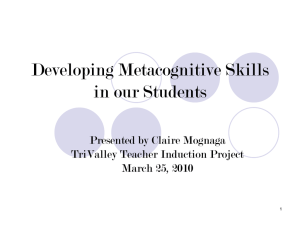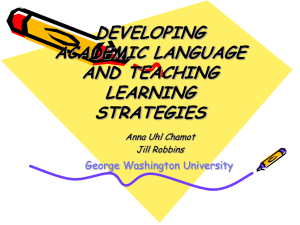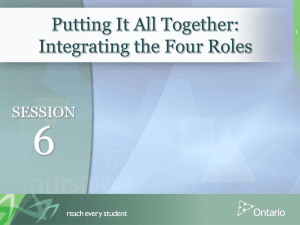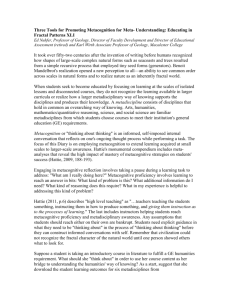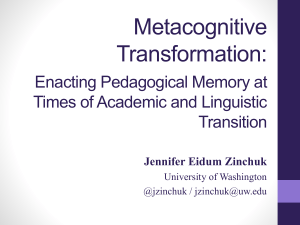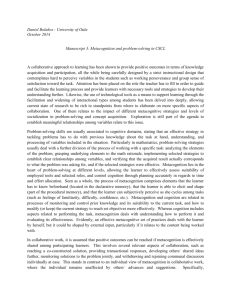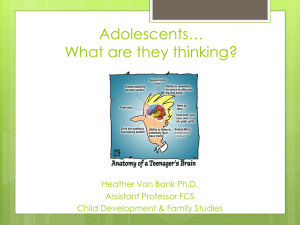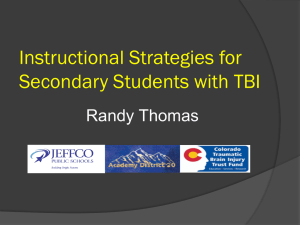APA Format 6th Edition Template - Donna A. McElveen Instructional
advertisement
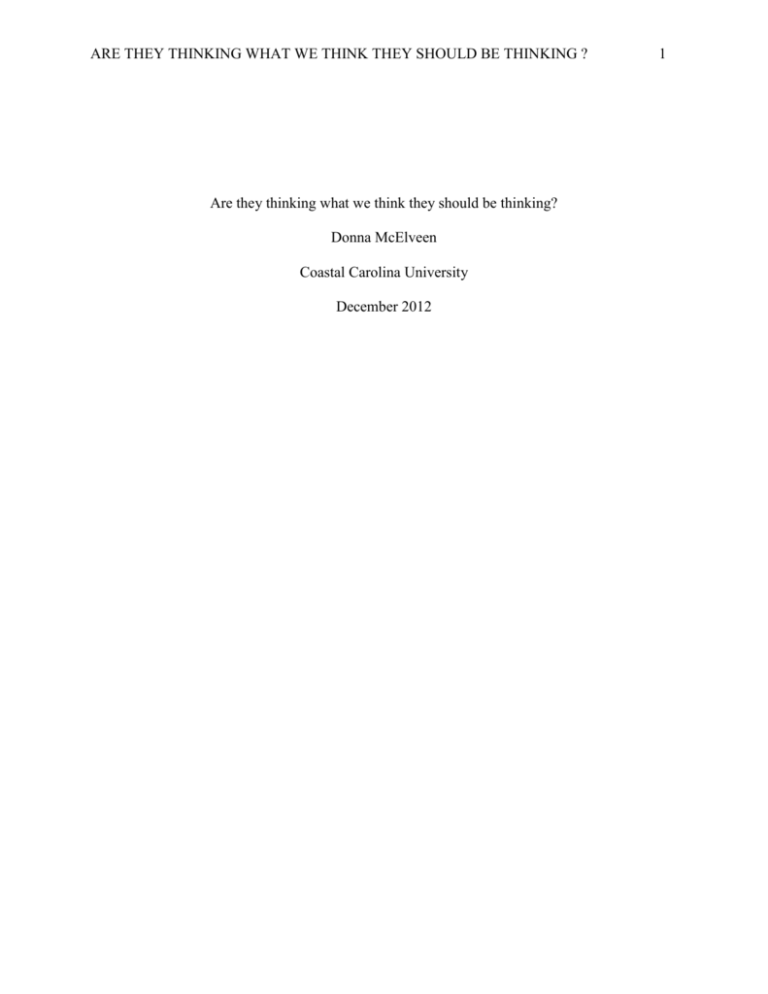
ARE THEY THINKING WHAT WE THINK THEY SHOULD BE THINKING ? Are they thinking what we think they should be thinking? Donna McElveen Coastal Carolina University December 2012 1 ARE THEY THINKING WHAT WE THINK THEY SHOULD BE THINKING ? 2 Are they thinking what we think they should be thinking? Purpose The goal of this study was to determine if there is a correlation between an elementary students' reading level and their awareness of metacognitive strategies they may use in the process of reading. With this knowledge teachers can teach the reading strategies that students need to be successful. Justification Educational theorists stress the importance of metacognition for regulating and supporting student learning. The Partnership for 21st Century Skills has identified self-directed learning as one of the life and career skills necessary to prepare students to compete globally in this century. In SC as we move towards Common Core Standards students in even earlier grades will be required to understand why and how they arrived at a solution to a problem. Research has shown that metacognition develops at different ages and in varied degrees depending on the student. Knowing what metacomprehension strategies students are using or not using will yield valuable instructional information for teachers. Research question and hypothesis Are students who are aware of their metacognitive strategies throughout the reading process more effective readers? Is there a correlation between their knowledge and reading level? My hypothesis is that there will be a positive correlation. ARE THEY THINKING WHAT WE THINK THEY SHOULD BE THINKING ? 3 Definitions Metacognitive: "cognition about cognition", or "thinking about thinking “. Metacognition refers to one’s knowledge concerning one’s own cognitive processes or anything related to them, the learning-relevant properties of information or data. Metacomprehension: an awareness of your own level of understanding for some given material and the conscious knowledge and use of strategies to achieve understanding Reading strategy: Plans or methods that can be used or taught to facilitate reading proficiency. Reading comprehension: the meaning gained from what is written on the page Overview There has been much research demonstrating that metacognition develops at different ages and in varied degrees depending on the student. The connection however between reading with understanding and what strategies students use to be successful is not so well defined. Therefore this research will address the question if students who are aware of their metacognitive strategies throughout the reading process are more effective readers? A secondary question will be considered. Is there a correlation between their knowledge and reading level? The knowledge of what metacomprehension strategies students are using or not using will yield valuable instructional information for teachers. With this information teachers can identify and teach the reading strategies that students need to be successful. Background and review of literature Going back to the roots of the Educational theory of Piaget researchers have established the basis for understanding a young child’s metacognitive ability. Literature and subsequent research on the metacognition of preschool and elementary-aged children, has shown that ARE THEY THINKING WHAT WE THINK THEY SHOULD BE THINKING ? 4 metacognitive capacities appear, develop, and improve over time with age. In the discussion of the development of metacognition Kuhn (2000) describes the process as a gradual movement to replace deficient cognitive strategies with more effective ones. Several researchers have concluded that metacognitive abilities appear to improve with age (Cross & Paris, 1988; Hennessey, 1999; Kuhn & Dean, 2004; Schneider, 2008; Schneider & Lock, 2002) They agree that metacognitive development progresses through stages with cognitive knowledge appearing first, with children as young as age 6 able to reflect on the accuracy of their cognition, and consolidation of these skills typically evident by 8-10 years of age. Ability to regulate cognition appears next, with dramatic improvements in monitoring and regulation appearing by 10-14 years of age in the form of planning. Monitoring and evaluation of cognition are slower to develop and may remain incomplete in many adults. Lastly, the development of metacognitive theories if they are present, appear. Contemporary theorists such as McLeod (1997) felt that children are unable to use formal thinking processes that are needed for metacognition. Early studies on the metacognitive capacities of young children concluded is a latedeveloping skill (Flavell, 1979; Schraw & Moshman, 1995; Whitebread et al., 2009). Analyzing the results of early studies, Flavell (1979) argues that young children have difficulty appraising their own ability to memorize a set of objects and identifying what they do and do not understand about a set of written instructions. Schraw and Moshman (1995) note that young children have difficulty monitoring their thinking during task performance and constructing metacognitive theories frameworks that integrate cognitive knowledge and cognitive regulation. However, more recent empirical studies suggest that the conclusions of earlier studies may be inaccurate. A contrasting study included 250 children in upper elementary grades in Macedonia and the Greek Islands of the Agean. It focused on the differences between how learning disabled ARE THEY THINKING WHAT WE THINK THEY SHOULD BE THINKING ? 5 students do use metacognitive skills, but with less depth than non- learning disabled students. Padeliadu, Botsas and Sideridis (2000) found that learning disabled students have skills in specific areas such as planning strategies. Where some problems arise for these students is being able to discern which strategy to use when. This is especially noticeable in the anticipation before reading sequencing, and self-monitoring of comprehension. Researchers feel there is a strong correlation between the effects of metacognition on comprehension and therefore this researcher feels it is important to understand the definition and theories behind metacognitive awareness. One study included four tests of comprehension which suggested that good readers may not be better in their awareness of metacognition. Perry (1998) He believes the differences are due more to language acquisition. This study recommends that struggling readers should be provided with acquisition based reading curriculum that allows students to reflect on their reading process. This approach is found in programs that are literature based and include all types of genres. Proponents of this curriculum feel that these types of works naturally provide opportunities for students to communicate and construct meaning. A few researchers have offered general suggestions for measuring or assessing metacognition. For example, Schraw and Moshman (1995) favor verbal report methods because they allow researchers to access aspects of thinking that are not directly observable. On the other hand, Whitebread et al. (2009) argue that observational methods have advantages over self-report and think-aloud methods. Observational approaches record actual learner behaviors, which enables nonverbal behaviors to be taken into account. Further, observational techniques can record social processes that may be important in acquisition of metacognitive skills. Kramarski and Mevarech (2003) recommend using instructional tasks that are complex, allow multiple representations of concepts, and afford students opportunities to identify and resolve conceptual conflicts. Finally, ARE THEY THINKING WHAT WE THINK THEY SHOULD BE THINKING ? 6 Perry (1988) notes that writing activities, especially those involving students in all stages of the writing process (planning, drafting, editing, and revising) offer ample opportunities for selfregulated learning. Sperling et al. (2002) developed and administered a self-report instrument for measuring general metacognitive knowledge and regulation in children in grades 3-8. Researchers have noted challenges in assessing metacognition. First, Whitebread et al. (2009) argue that self-report methods, such as the use of rating scales or questionnaires that ask respondents to describe their use of particular strategies, rely too heavily on verbal ability. Thus, self-report and think-aloud techniques may be especially likely to underestimate the abilities of young children. Another common method for capturing metacognition is the use of self-report questionnaires or rating scales. Kramarski and Mevarech (2003) used a metacognitive questionnaire, assessing both general metacognition and what they called domain-specific metacognition (math strategies). Students were presented with a range of strategies and asked to indicate whether and how often they used the strategies. The Burke Reading Inventory is another instrument that assesses the use of student’s metacognitive strategies. It will be used in this research study, along with a metacognitive picture protocol. (Cobb and Ellerbe 2011). Using tools such as these will allow teachers and students to know strengths and weaknesses. (Moore et al, 1997.) Teachers can then chose appropriate strategies to meet the needs. In curriculum application best practice research suggests a gradual and total inclusion method of instruction of metacognitive skills. The reasoning behind the authors’ suggestion correlates with the fact that early readers are focused on decoding and not comprehension. This will include making the child aware that metacognitive knowledge exists; it will then go on to consolidate comprehension as a reading objective and eventually aim at the acquisition of new strategies and ARE THEY THINKING WHAT WE THINK THEY SHOULD BE THINKING ? 7 their association with specific cognitive tasks. Other researchers recommend a number of specific instructional strategies, including providing explicit instruction in both cognitive knowledge and cognitive regulation, using collaborative or cooperative learning methods, using tasks and activities that make student conceptions and beliefs visible, promoting awareness of metacognition through teacher modeling, and attending to the affective and motivational aspects of metacognition. The most effective instructional strategies included the textual-dissonance approach, selfquestioning, and backward-forward search strategies. Researchers have recommended a number of specific instructional approaches to teaching metacognition. For example, Cross and Paris (1988) recommend providing explicit instruction in declarative, procedural, and conditional knowledge. While Schraw et al. (2006) urge educators to provide explicit instruction in cognitive and metacognitive strategies. In addition to providing instruction on cognitive knowledge, educators should also assist students in developing their abilities to monitor and regulate their cognition. Kuhn (2000) points out that instruction for metacognition should be delivered at the meta-level rather than the performance level. Schraw (1998) recommends providing explicit prompts to help students improve their regulating abilities. Kramarski and Mevarech (2003) provided students with sets of metacognitive questions, including comprehension questions, strategic questions, and connection questions, to be completed during the task. Teachers also need to promote general awareness of metacognition by modeling metacognitive skills during instruction, perhaps by thinking aloud¨ (Kramarski & Mevarech, 2003; Martinez, 2006; Schraw, 1998. ARE THEY THINKING WHAT WE THINK THEY SHOULD BE THINKING ? 8 To be successful higher level thinkers students must understand why and how to think about thinking. Researchers differ in their opinions as to when and to what level these abilities develop. Although individual developmental models vary, in general, an area of agreement is that metacognitive ability is present during the first 6 years of life, with the most dramatic changes occurring between the ages of 3 and 4. Metacognition improves with both age and appropriate instruction, with substantial empirical evidence supporting the notion that students can be taught to reflect on their own thinking. Researchers recommend a number of specific instructional strategies, including providing explicit instruction in both cognitive knowledge and cognitive regulation, using collaborative or cooperative learning methods, using tasks and activities that make student conceptions and beliefs visible, promoting awareness of metacognition through teacher modeling. The summary of literature suggests that the assessment of metacognition is not clearly defined. A variety of methods for measuring metacognition include self-report methods such as questionnaires or rating scales, think-aloud approaches that attempt to make student thinking visible, and methods based on teacher observation of student learning. So, what can educators do to improve their student’s metacomprehension abilities? Researchers recommend a number of specific instructional strategies, including providing explicit instruction in both cognitive knowledge and cognitive regulation, using collaborative or cooperative learning methods, using tasks and activities that make student conceptions and beliefs visible, promoting awareness of metacognition through teacher modeling. A good start might be using a reliable metacognitive scale as a means to assess metacomprehension skills in learners. Then after analyzing the results teachers need to instruct students in the research based ARE THEY THINKING WHAT WE THINK THEY SHOULD BE THINKING ? 9 strategies designed to increase reading comprehension. As a learner, knowing your own strengths and weaknesses as well as the strategies that best fit your needs is critical to metacomprehension. Procedures Research Design This research is a correlational study with data gathered by a student survey. The analysis will be qualitative in nature, however there will be other quantitative gathered in the study that will not be correlated to this data. The sample is a purposive one as teachers in each second grade classroom selected students they felt need additional reading support and were are not receiving other services. Sample Twenty six pre-service teachers at Coastal Carolina University administered a battery of reading assessments to 26 second grade students at Socastee Elementary in Horry County, South Carolina. The students were enrolled in six different second grade classes. The Literacy Pals Project creates a one to one relationship of selected second graders with their University Partner. Instruments Standard measures of early reading skills along with a Metacomprehension Picture Protocol survey designed by Cobb and Ellerbe at Coastal Carolina University ( 2011 ) were given. The MPP was designed by Dr. Jeanne Cobb as part of a grant. Dr. Cobb consulted with Mary Beth Schmidt who developed a similar inventory for older students. She made some recommendations to revise the rather lengthy instrument to a shorter one that included pictures. Dr. Cobb designed an easier picture based protocol for younger elementary students. Then Dr. Marcie Ellerbe revised this instrument and added some additional pictures to represent a more diverse background of students. The Burke Reading Inventory was also administered. It is an inventory ARE THEY THINKING WHAT WE THINK THEY SHOULD BE THINKING ? 10 that is student survey driven . The data that will be measured is how the second graders perceive themselves and others as good readers and if they are aware of strategies they use in the reading process. This study will also include a discussion of the reading levels of each student as compared to their ability to use metacognitive strategies. Procedures The study began with the preservice teacher meeting with their “ Literacy Pal” during one session to establish rapport and then during the second visit the Metacognitive Picture Protocol was administered. Students were shown a picture of a “good reader “. Pictures of children of different gender and ethnicity were selected by the examiners to closely represent the student. While viewing the picture students were asked a several questions regarding their perception of themselves as “good readers “ and what strategies good readers use before, during and after reading. The data from both instruments measured was if second graders perceive themselves as good readers and the strategies they use in the reading process. Burke Inventory Question #10Do you think you are a good reader ? The question on the Metacognitive Picture Protocol was Question #4- What strategies do you use ? The responses will be discussed in the findings section of this paper. The student’s descriptions were analyzed, categorized, and compared. Validity With regard to internal validity there are areas that may not be able to be controlled for but will be discussed. First, these are second grade students who had only met their preservice teacher for 2 days prior to testing. There may be an attempt to “please the teacher” and supply the answers to the survey questions that they feel is wanted. On the other hand students may also have anxiety with someone they are not familiar with. Because the responses are based ARE THEY THINKING WHAT WE THINK THEY SHOULD BE THINKING ? 11 on the student’s reflection, honesty may also be a concern. The strategy the student may also not be their own but one they have heard others use. The student may know the name of the strategy but is not able to demonstrate it. Language may also be a limitation for some students due to the fact that prior teachers may have used a different name of a strategy than used in the test setting. The test administrators have been given guidance on how to attempt to overcome these challenges to the best of their ability. As far as external validity and the ability to generalize this study the setting is a title one school with over 90% free and reduced lunch population. There are many schools in Horry County and across the country that closely resemble the makeup of the population of this school. We can generalize this study to other second grade elementary student who are struggling readers. There also needs to be some internal validity testing with the instrument itself due to its unique nature and the fact there are no other picture protocols for lower elementary students. Findings Data for 24 students collected yielded a positive correlation between students’ self-awareness of metacognitive strategies and their perception of themselves as good readers. An independentsamples t-test was conducted to compare student strategy awareness and perception of themselves as good readers. Results were 0.003121 which is a significant correlation that suggest students who feel they are good readers use and are aware of strategies they use. This is in support of the original hypothesis of this study. The data gathered from the student survey as to if the students perceived themselves as a good reader revealed eighteen students thought they were good readers, four were unsure and two reported they were not good readers. This data is summarized in Table 1. It was interesting that of the two students who did not perceive themselves as a good reader, one of them scored significantly above grade level on the San ARE THEY THINKING WHAT WE THINK THEY SHOULD BE THINKING ? 12 Diego reading assessment. The other was significantly below grade level. This is a test of word recognition only. Data also revealed that students use a variety of strategies before, during and after reading. The most common strategies students described were phonics based. They were “sound out the word “, “blend,” and “try to break the word down.” The next most popular strategy was to use the pictures or “take a picture walk “. Discussion Reading levels of each student as compared to their ability to use metacognitive strategies suggest high correlation. Students may not know what strategies are called but can describe them. Students who perform at or above grade level perceive themselves as good readers along with those who are not a grade level. The most common strategy described was to sound it out which may suggest that at the second grade level these students are still focused on word decoding and have not moved to comprehension yet. Another strategy students used was looking at the pictures. Evidence good readers move from text to pictures and back to text to make sense of what they are reading (Rusted & Colt heart). Pictures then become invaluable tool for teaching comprehension. Successful metacognitive literacy instruction should address the following components: student background knowledge and schema development, knowledge and practice of a set of developmentally appropriate metacognitive strategies, knowledge of the conditions for the deployment of compensatory strategies, teacher modeling and scaffolding. There were also several off target comments as to the strategies used such as “ask the teacher, or parent, shrugging of shoulders, “nothing special “, and no response. These students seemed to have a lack of language skills as well as being below reading level on the word recognition tests. ARE THEY THINKING WHAT WE THINK THEY SHOULD BE THINKING ? 13 Further Research More research is needed to determine to what extent educators should promote metacognitive instruction. Researchers differ on the types of instructional recommendations they feel would be effective. Trying to isolate the best strategies and analyzing how does a reader decides what processes to use and under what circumstances would be valuable to elementary teachers. One interesting piece of information that came to light in this study was that some teachers had more students who were very aware of the strategies they used and were better readers. It would be interesting to research if teachers who teach cognitive strategies explicitly produce better readers in the classroom. Additional research is also needed to determine if the age of the learner influences what strategy they use. Additional data in terms of larger samples are needed to see if there a correlation between strategies and reading level as shown on tests of comprehension, and word recognition. More information is needed on this topic with upper elementary students, special needs and ELL learners. Finally tests of comprehension rather than simply word recognition would be valuable to include in this study. ARE THEY THINKING WHAT WE THINK THEY SHOULD BE THINKING ? 14 References Bailin, S., Case, R., Coombs, J. R., & Daniels, L. B. (1999). Conceptualizing critical thinking. Journal of Curriculum Studies, 31(3), 285-302. Carlson, S. M. & Moses, L. J. (2001). Individual differences in inhibitory control and children¡¦s theory of mind. Child Development, 72(4), 1032-1053. Case, R. (2005). Moving critical thinking to the main stage. Education Canada, 45(2): 45-49. Cross, D. R. & Paris, S. G. (1988). Developmental and instructional analyses of children¡¦s metacognition and reading comprehension. Journal of Educational Psychology, 80(2), 131-142. Eisenberg, N. (2010). Self-Regulation and School Readiness. Early Education and Development, 21(5), 681-698. Ennis, R. H. (1985). A logical basis for measuring critical thinking skills. Educational Leadership, 43(2), 44-48. Flavell, J. H. (1979). Metacognition and cognitive monitoring: A new area of cognitivedevelopmental inquiry. American Psychologist, 34(10), 906-911. Gottfried, A. E. (1990). Academic intrinsic motivation in young elementary school children. Journal of Educational Psychology, 82(3), 525- 538. Haller, E. P., Child, D. A., & Walberg, H. J. (1988). Can comprehension be taught? A quantitative synthesis of metacognitive studies. Educational Researcher, 17(9), 5-8. Halpern, D. F. (1998). Teaching critical thinking for transfer across domains: Dispositions, skills, structure training, and metacognitive monitoring. American Psychologist, 53(4), 449-455. Hennessey, M. G. (1999). Probing the dimensions of metacognition: Implications for conceptual change teaching-learning. Paper presented at the annual meeting of the National Association for Research in Science Teaching, Boston, MA. Kramarski, B. & Mevarech, Z. R. (2003). Enhancing mathematical reasoning in the classroom: The effects of cooperative learning and metacognitive training. American Educational Research Journal, 40(1), 281-310. Kuhn, D. (2000). Metacognitive development. Current Directions in Psychological Science, 9(5), 178-181. Kuhn, D. & Dean, D. (2004). A bridge between cognitive psychology and educational practice. Theory into Practice, 43(4), 268-273. Lipman, M. (1988). Critical thinking. What can it be? Educational Leadership, 46(1), 38-43. Martinez, M. E. (2006). What is metacognition? Phi Delta Kappan, 696-699. McLeod, L. (1997). Young children and metacognition: Do we know what they know they know? And if so, what do we do about it? Australian Journal of Early Childhood, 22(2), 6-11. Paris, S. G. & Winograd, P. (1990). Promoting metacognition and motivation of exceptional children. Remedial and Special Education, 11(6), 7-15. Perry, N. E. (1998). Young children¡¦s self-regulated learning and contexts that support it. Journal of Educational Psychology, 90(4), 715-729. Ray, K, & Smith, M. C. (2010). The kindergarten child: What teachers and administrators need to know to promote academic success in all children. Early Childhood Education Journal, 38(1), 5-18. ARE THEY THINKING WHAT WE THINK THEY SHOULD BE THINKING ? 15 Schneider, W. (2008). The development of metacognitive knowledge in children and adolescents: Major trends and implications for education. Mind, Brain, and Education, 2(3), 114-121. Schneider, W. & Lockl, K. (2002). The development of metacognitive knowledge in children and adolescents. In Perfect, T. & Schwartz, B. (Eds.), Applied metacognition. Cambridge, UK: Cambridge University Press. Schraw, G. (1998). Promoting general metacognitive awareness. Instructional Science, 26(1-2), 113-125. Schraw, G., Crippen, K. J., & Hartley, K. (2006). Promoting self-regulation in science education: Metacognition as part of a broader perspective on learning. Research in Science Education, 36, 111-139. Schraw, G. & Moshman, D. (1995). Metacognitive theories. Educational Psychology Review, 7(4), 351-371. Sperling, R. A., Howard, B. C., Miller, L. A., & Murphy, C. (2002). Measures of children¡¦s knowledge and regulation of cognition. Contemporary Educational Psychology, 27, 51-79. Tindal, G. & Nolet, V. (1995). Curriculum-based measurement in middle and high schools: Critical thinking skills in content areas. Focus on Exceptional Children, 27(7), 1-22. Whitebread, D., Coltman, P., Pasternak, D. P., Sangster, C., Grau, V., Bingham, S., Almeqdad, Q., & Demetriou, D. (2009). The development of two observational tools for assessing metacognition and self-regulated learning in young children. Metacognition and Learning, 4(1), 63-85. Willingham, D. T. (2007). Critical thinking: Why is it so hard to teach? American Educator, 819. ARE THEY THINKING WHAT WE THINK THEY SHOULD BE THINKING ? 16 Table 1 Burke Inventory Question #10 revealed out of the 24 students tested there were 8 students Four students said they were unsure and 2 stated they were not good read Burke Inventory Question #10 revealed out of the 24 students tested there were 8 students who thought they were good readers. Four students said they were unsure and 2 stated they were not good readers.
